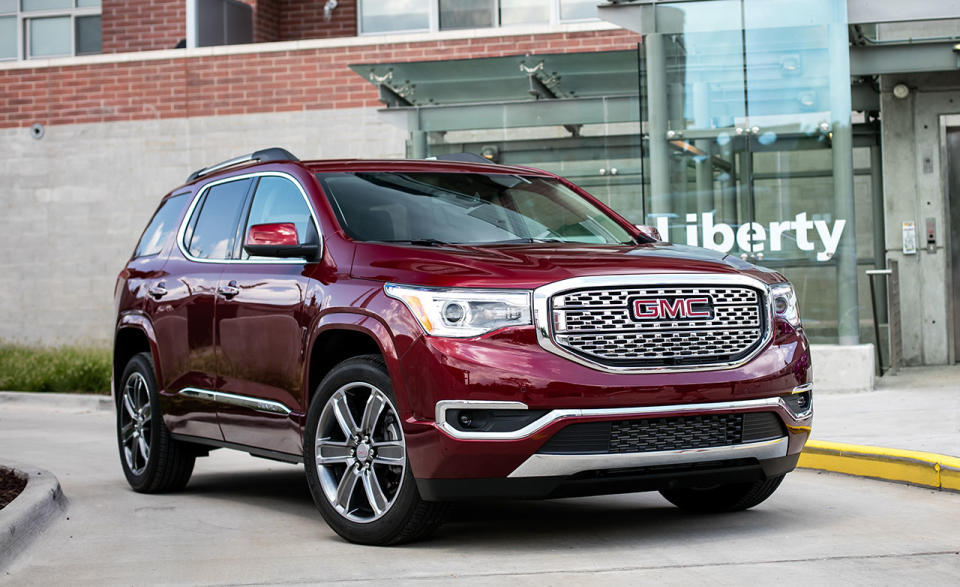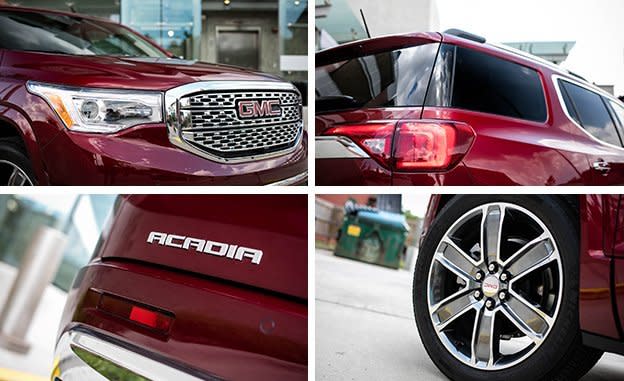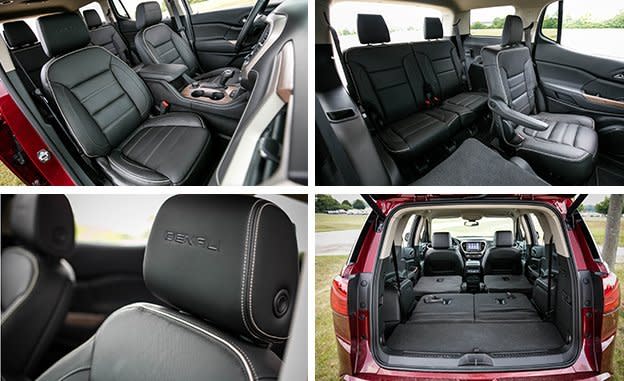2017 GMC Acadia Denali AWD

Fortunes are built on meeting expectations. Every Big Mac is the same at every McDonald’s. Lightsabers are stupid weapons, but they’re in every Star Wars movie. The WWE is a business empire built on preordained results. And the 2017 GMC Acadia Denali is exactly what you expect of a vehicle sharing its name with not one, but two U.S. national parks.
Not that there’s anything wrong with that. Is there?

Marqued Difference
GMC has been in the SUV business longer than most of the competition has even existed. The GMC Suburban hit the market in 1937, or 61 years before Lexus began churning out the RX300 and 66 before Porsche introduced the big-leap-of-sports-car-betrayal that is the Cayenne. But that Suburban was a truck, and GMC’s existence has always been justified as being the division that builds trucks for people who just like trucks. The Acadia Denali may be the least trucklike thing ever to wear the brand’s logo.
The Denali is the loaded-up, top-rung member of the Acadia family. Redesigned for 2017, the new Acadia moves from the previous generation’s decade-old Lambda platform that it shared with the Chevrolet Traverse, Buick Enclave, and long-dead Saturn Outlook to General Motors’ new C1 platform, designed specifically to underpin mid-size and full-size crossovers. GMC shares the C1 goods with the 2017 Cadillac XT5 and new Buick and Chevy variants coming soon. The big difference between the two generations of Acadia is the bigness. The new one has less of it.
Where the first Acadia put 118.9 inches between its front and rear axles, the second generation sees that distance shrink to 112.5. That 6.4-inch decrease in wheelbase comes along with a 7.2-inch reduction in overall length, to 193.6 inches. Throw in a 3.5-inch slimming of the overall width and it’s apparent that the Acadia has dropped from dreadnought to cruiser—or full-size to mid-size. Despite this compaction, the Acadia again boasts three rows of seats, and the rearmost is still somewhat usable by toddlers. Small, tiny toddlers.
At 4399 pounds on our scales, the Acadia Denali is nowhere near being a lightweight. Nonetheless, it’s down 653 pounds from the last all-wheel-drive Acadia that C/D road tested—way back in 2007. That significantly improves the weight-to-power ratio from the W. Bush–era machine’s 18.4 pounds per horsepower to just 14.2 today.

Looking for Drama? Try Netflix
There’s nothing shocking about what’s under the Acadia Denali’s skin. The front suspension is by struts, while the rear employs a new multilink independent system. The steering is now handled by an electrically assisted rack-and-pinion system that is fitful about communicating. And what it does end up saying is more slow-and-lazy C-SPAN than high-drama HBO.
Powering the Acadia Denali is a version of the redesigned direct-injected 3.6-liter V-6 that GM installs in everything from the Chevy Colorado pickup to the Cadillac CT6 luxury sedan. It’s capable of running on four cylinders during light load conditions and shares little with the 3.6-liter V-6 powering the outgoing Acadia (which, by the way, for 2017 is soldiering on alongside the new model but under the Acadia Limited nameplate). Output of the new engine is 310 horsepower instead of 281 or 288. There’s still a six-speed automatic aboard the Acadia Denali, though, which seems anachronistic in an age where 10-speeds are the latest thing and the Cadillac stablemate uses an eight-speed.
Naturally both front- and all-wheel drive are offered. This Acadia Denali was an all-wheel-drive version riding on the standard 20-inch wheels wrapped in 235/55 Michelin Premier LTX tires. All in all, dipped in Crimson Red Tintcoat, it was about as handsome as a crossover gets, even if the blindingly shiny, chromed-plastic grille is a step beyond tasteful. Excess chrome is to the 21st century what vinyl woodgrain was to the 20th. Actually, the Acadia Denali might look pretty good with some phony wood glued to its flanks.

The Subdued Abides
The interior is relentlessly tasteful. It’s all about subdued colors, subdued real wood and chrome accents, subdued leather upholstery, and subdued bolstering on the very comfortable front seats. The rearward seats are, on the other hand, largely flat and shapeless. While up to seven can be crammed into other Acadia models, the Denali comes only as a six-seater. Since there are just five USB ports, one rider will need to risk running their device dry or bring an adapter to use with the 12-volt socket or the 120-volt household-style outlet.
There’s a satisfying mechanical heft to the Acadia Denali’s console-mounted shifter that belies the reality that it’s really an electric switch. Still, we appreciate that GMC stayed with a traditional PRNDL lever here instead of trying to reinvent shifting as others do with buttons and knobs and dials. That said, GMC is not above such folderol—witness the 2018 Terrain’s odd shifter. In the Acadia, manual gear selection is via a little thumb button atop the knob, where it does nothing to encourage driver involvement but at least provides easy access when you find yourself gaining speed down a long mountain grade.
As one expects of a mainstream crossover, the seating positions are tall and visibility is quite good. GM’s switchgear seems to get better with every passing model, and there’s a neat feature on the door-mounted control for opening the rear power liftgate that allows the driver to dictate how far the gate will open, the better to avoid thumping the ceiling in, say, a low-roof carport. We remember when you had to get off your bucket to do that, son.
GM’s integration of personal technology is also impressive. There’s an 8.0-inch touchscreen at the top of the dashboard center stack that’s relatively intuitive to use on its own and utterly simple when running the Apple CarPlay system through an iPhone (Android Auto is aboard, too). And, predictably, all sorts of other tech is present and accounted for. The test machine carried an adaptive cruise-control system that also incorporates automated braking from high speed to full stop that no one here had the guts to test.
With both the second- and third-row seats in place, there’s only 13 cubic feet of usable storage space behind them. Fold the rearmost row and that expands to 42 cubic feet. Fold the second-row seats (which are, incidentally, heated) and GMC claims a full 79 cubic feet between the front buckets and the tailgate. The comparable interior-volume numbers for the Mazda CX-9, for example, are 14, 38, and 71 cubes.

Getting Down to Work
As sweet natured as the 3.6-liter V-6 is, it lacks a noticeable voice or much character. It’s a solid performer that traipses from zero to 60 mph in 6.1 seconds and can cover the quarter-mile in 14.9 seconds at 94 mph. The all-wheel-drive CX-9, powered by a 250-hp turbo 2.5-liter inline-four, needs 1.1 seconds more to reach 60 and runs the quarter-mile in 15.7 seconds at 88 mph. The Acadia Denali’s acceleration is roughly equivalent to that of the V-6–powered Honda Pilot and Ford Explorer Sport.
The EPA rates the Acadia Denali at 18 mpg in the city, 25 mpg on the highway, and 20 mpg combined. In 1100 miles of mixed driving, we achieved 21 mpg. The slightly more economical 2.5-liter four-cylinder engine offered in other Acadia models is not available in the Denali.
What’s most satisfying about the Acadia’s performance is how it reacts when pressed. Dive deep into a corner and the front end pushes a bit and then this crossover regains its composure with the application of some throttle engaging the all-wheel-drive system. This thing may be built for hauling kids to piano lessons, but it has apparently learned a few valuable lessons on GM’s “Lutzring” handling test track, too. Some credit must go to the optional ($1200) continuously variable damping system with which this Acadia Denali was equipped. It’s impossible to think of a reason to order an Acadia Denali without those dampers. And the brakes are good and proved very near fade-free after repeated hard stops.
Still, initial turn-in could be better. Keep that in mind 15 or so years from now when you’re ready to campaign an Acadia Denali in the 24 Hours of LeMons. By then it should have fully depreciated from its $52,485 as-tested price.

So Well Rounded that Nothing’s Sharp
GM has burnished the Acadia Denali to the point that a rough edge somewhere in its character would be appreciated. A slight rasp to the exhaust note and a pair of pointless paddle shifters could almost pass as delightful eccentricities. But this GMC competes in a market where all the players are similarly glossy and comprehensively well thought out.
This may as well be the GMC Acadia Denali by Marriott. It’s any room at a Courtyard hotel; which is to say it’s just like every other room at every other Courtyard. It’s all tasteful and viceless, right down to the close-up photo of water beading along the edge of a bright-green leaf hanging on the bathroom wall. There’s good, reliable Wi-Fi in the GMC, too. But it’s barely distinguishable from most other competitors. It’s all fine, but it’s not flavorful. All that’s missing in the Acadia Denali is an edge and a free breakfast buffet.
Specifications >
VEHICLE TYPE: front-engine, all-wheel-drive, 6-passenger, 4-door hatchback
PRICE AS TESTED: $52,485 (base price: $47,995)
ENGINE TYPE: DOHC 24-valve V-6, aluminum block and heads, direct fuel injection
Displacement: 223 cu in, 3649 cc
Power: 310 hp @ 6600 rpm
Torque: 271 lb-ft @ 5000 rpm
TRANSMISSION: 6-speed automatic with manual shifting mode
DIMENSIONS:
Wheelbase: 112.5 in
Length: 193.6 in
Width: 75.4 in Height: 66.0 in
Passenger volume: 144 cu ft
Cargo volume: 13 cu ft
Curb weight: 4399 lb
C/D TEST RESULTS:
Zero to 60 mph: 6.1 sec
Zero to 100 mph: 17.2 sec
Zero to 120 mph: 29.9 sec
Rolling start, 5–60 mph: 6.5 sec
Top gear, 30–50 mph: 3.5 sec
Top gear, 50–70 mph: 4.8 sec
Standing ¼-mile: 14.9 sec @ 94 mph
Top speed (governor limited): 131 mph
Braking, 70–0 mph: 170 ft
Roadholding, 300-ft-dia skidpad*: 0.85 g
FUEL ECONOMY:
EPA combined/city/highway driving: 20/18/25 mpg
C/D observed: 21 mpg
C/D observed 75-mph highway driving: 23 mpg
C/D observed highway range: 430 mi
*stability-control-inhibited

 Yahoo Finance
Yahoo Finance 